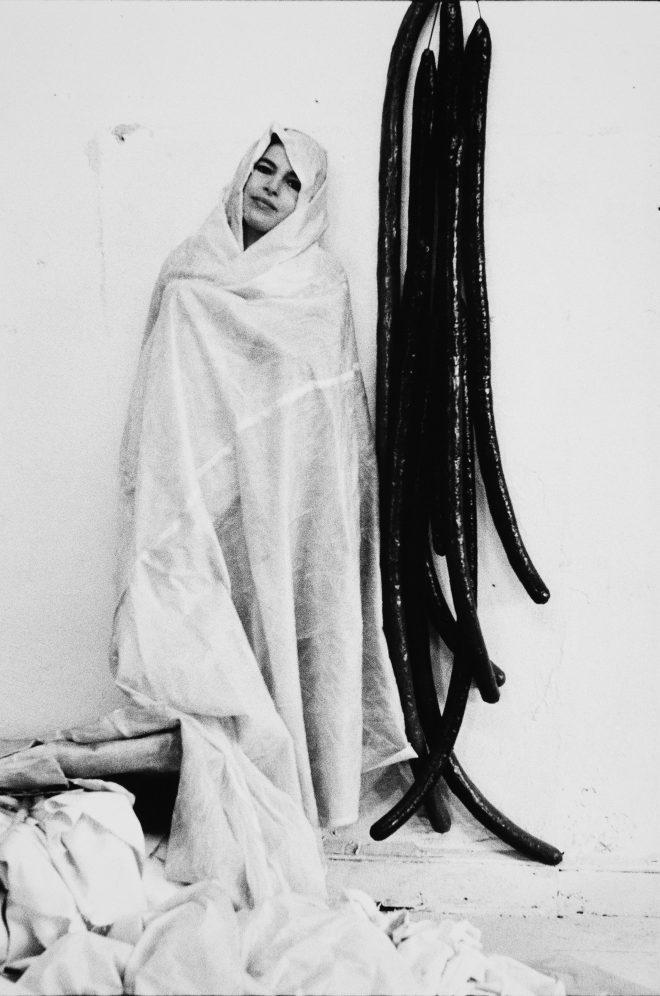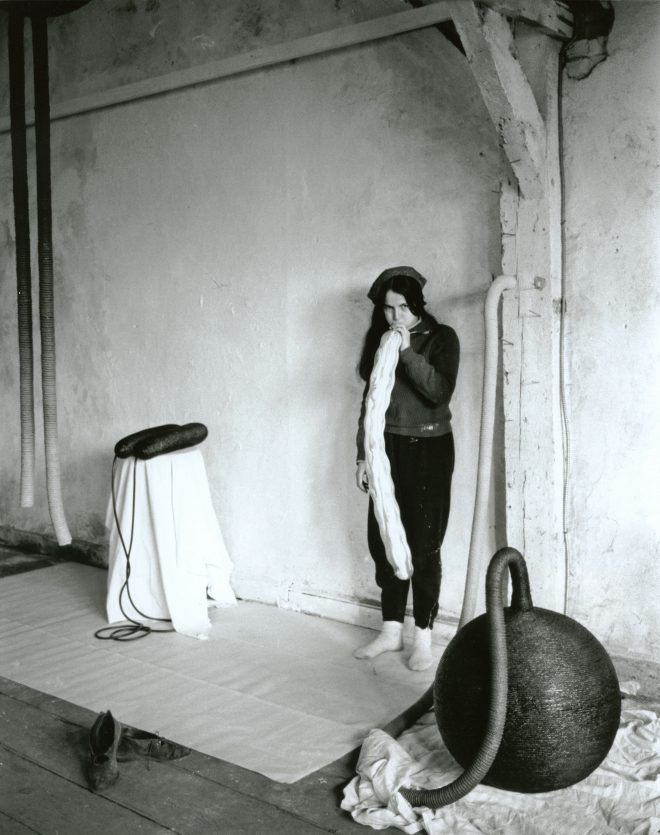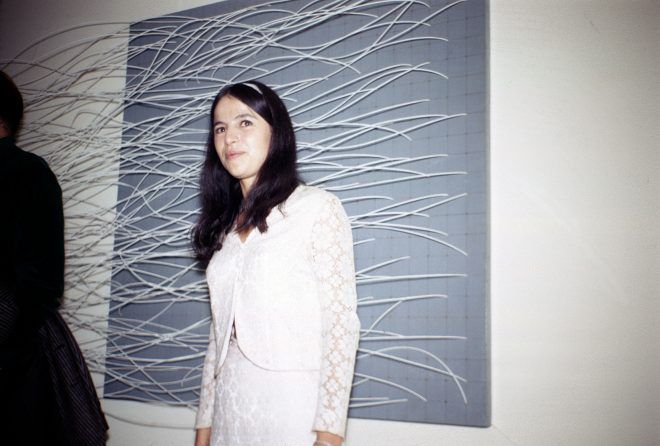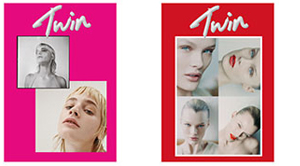It’s easy to see artist Eva Hesse’s life as a huge Hollywood epic, filled with love, passion, tragedy and early death. She was not only surrounded by some of the most influential artists of her time, she was one of them. But Marcie Begleiter’s documentary about the artist takes another route, focusing on remarkable artworks and a personality that resonates through time.
It was in graduate school that filmmaker Marcie Begleiter first discovered the artist Eva Hesse. She was looking for something else than the ironic, sometimes distanced work that was lauded in art magazines in the late 1980’s. “I wanted a deeper connection,” Begleiter reflects. “When I saw Hesse’s work in reproduction I was very moved. It was smart and logical, but it also pushed against that with droopy materials. It had a great shifting to it. Eva didn’t simply find something that worked and stayed there, she shifted and changed.”
It’s hard, almost impossible, to describe Eva Hesse’s work in words. During her active years the expression and method was in constant development, and her journey from painter to sculptor shifted with an almost forceful passion. She would within her short life become one of the most important and influential artists of her time. Showing her work together with contemporaries like Carl Andre, Dan Graham, Mel Bochner and Sol LeWitt – almost always as the only woman in the group.
Her early work is mainly abstract paintings that during a residency in Germany started taking a more physical form – somewhere in between a sculpture and a painting. The later sculptures, made in her final years before losing the battle with brain cancer at the early age of 34, are big evocative constructions made with latex, fiberglass, rope and a mixture of mechanical trinkets. But still with a soft, almost sexual appearance.

Eva Hesse in 1968. Photo by Herman Landshoff. Eva Hesse. A film by Marcie Begleiter. A Zeitgeist Films release.
Eva Hesse lived a life that kept shifting and changing as much as her art. A life that would have been impossible to do justice without the participation of the artist herself: the documentary is built around Hesse’s journals and letters, kept in the collection of Allen Memorial Art Museum in Oberlin, Ohio. With this extensive collection of writings (1 200 pages), Marcie Begleiter created a film where the artist’s voice rings clear. Through Eva’s own words (read in the film by actress Selma Blair) we are told an extraordinary story of a rather unusual life.
Eva’s life has the stuff of a true drama: Born to a German Jewish family in 1936 she was at age 3 put on the Kindertransport and sent to Holland together with her older sister Helen (only 5 years old at the time). Their parents managed to get out of Nazi Germany and collected their daughters at the Catholic children’s home where they were staying before they all fled to New York. The rest of their relatives were killed in concentration camps, a tragedy that deeply affected Hesse’s mother.
But the hardships didn’t end after the emigration. When Hesse was 10, her mother, in the wakes of a mental breakdown, committed suicide by jumping from the roof of a building. Later in life Hesse’s marriage with artist Tom Doyle would end in a bitter separation, and her beloved father would die suddenly and unexpectedly, leaving Hesse anxious and with a deep sense of abandonment. Still, Marcie Begleiter’s documentary isn’t tragic: It’s full of passion, art, humour and most of all of life. Until the very last breath.
– Ten different filmmakers would have made ten different films. I’m interested in artistic process and materials. There are aspects of Eva’s life that could be made sensationalistic. You have to allude to some of these things, because they are a part of the story, but what’s interesting is this person who faced enormous challenges in her life. Personal challenges and challenges in terms of the world around her, and still she found the persistence and the intelligence to create extraordinary drawings, paintings and sculptures. Even during the last year of her life, when she was greatly ill, she never stopped working. Not even from her hospital bed. And she had a great attitude about it: life doesn’t last, art doesn’t last. We still live our lives in the face of that fact.
The narrative is largely based on Evas letters and notes, could you tell me a little bit more about how you encountered and approached them?
– I had read Lucy Lippard’s book, and she quoted Hesse’s journals. A friend of mine, an arts librarian, told me that the original texts were in a tiny library in Ohio at Oberlin College. I can’t even tell you what compelled me to do it, but I wrote a grant proposal and I got funding to spend a couple of weeks reading through the material. The people at the library would bring me boxes and boxes and I sat there with white cotton gloves on and went through Eva’s personal papers. In the journals there were drawings, postcards from friends, announcements for shows. Her friends, once they knew that there was a library that kept her papers, sent in what they had. It’s all sorts of ephemera. It blew my mind. Here was this authentic, smart, insecure but absolutely self confident – kind of flipping back and forth between the pages – woman. I felt such a deep connection with the person that I encountered.
And after that you became interested in her as a subject for a documentary?
– Coming out of that first reading of the diaries I wrote a theatrical piece. A producer and friend of mine, Karen Shapiro, saw it and wanted to move it to a bigger venue. I felt that we had to get someone from the estate onboard if we wanted to do something bigger. My desire in meeting the people who knew Hesse was to begin a conversation about doing that project. But once I met Lucy [Lippard], Helen [Hesse–Charash] and Tom [Doyle], I felt it needed to be a film. I called Karen and told her that I met some interesting people in New York and that I had another idea. And she said “Oh you want to make a documentary, don’t you? ” and I answered “Yes, how do you know?” she said “I saw it in my meditation this morning. If you want to do that, I’ll produce it.” So I called Helen, to make sure that no one had done it before. She was extremely encouraging and very supportive in terms of giving us access to all materials they had.
Which part of Hesse’s life do you find most defining for her as an artist?
– I find it fascinating that she went back to Germany. This is 1964, less than 20 years after the end of the war. I went there in the 1980s and I had a hard time with it. But she went back to work in ’64, after everything that had happened to her family. She took the advantage to see Europe as an adult, to live without having extra jobs and just work. It was in Germany, partly under the pressure of being there, that she put aside traditional painting and started making three dimensional objects. That marked a real change for her. She started coming off the canvas. In the film it’s really the inciting incident of her life, that’s the change. She came back and she shot off like a rocket.
Did working with the film effect how you see and relate to Eva’s work today?
– I have come to the point where you can show me a drawing and I can pretty much nail the date of creation, within a year or two. There is a familiarity with the work that has deepened. What surprised me, is that after these years of working with her writing and her art, it has stayed fresh. I still find things that she wrote to be interesting, eye opening, inspiring and so thoughtful. It doesn’t get old.

Eva Hesse in 1966. Photo by Gretchen Lambert. Eva Hesse. A film by Marcie Begleiter. A Zeitgeist Films release.
I found the quote “Excellence has no sex” very inspiring. Do you think it’s relevant to mention feminism when you talk about Eva an artist?
– You can’t talk about feminism as if she was part of a movement, because she didn’t participate politically in that conversation. But she was defined by who she was, and not by what other people thought of her. In her lifetime she refused to be categorized as a female artist and she wasn’t in shows with only women. She wanted to be, aimed to be, and was, a part of the general conversation. That’s certainly a feminist stance even though she wouldn’t have used that language. Looking back, female artists of the 70s and 80s certainly saw Hesse as a touchstone, as someone who was being recognised as a peer with male contemporary artists. She was just doing what she needed to do and saying “I’m one of the best”.
From seeing the film it seems to me that whenever Hesse faced hardship, she grew. That it adds to her creativity.
– Everyone has tragedies in their life, maybe she had more than others, but it’s what she did with the tragedy that makes it interesting. That compels us to want to know more and gives us, the people looking, a connection to her bravery. Her tenaciousness and humour. I was talking to Rosie [Goldman] who’s in the film, she told me that she’d never seen anyone face death the way Eva did. There was no regret there. No regret. She was living every moment to the end. I really wanted to put that in the film. In our culture death is sort of a taboo issue, in America death is seen as a failure. A failure of modern science, a failure of medicine, a personal failure. We live a good life. We need to have a good death. And that’s something Eva did; she died a good death.
As part of a series of fundraising events in 2018, Orlando will be screening Eva Hesse at London’s Horse Hospital on Tuesday 6 February. Eva Hesse is also available on itunes and Amazon. Marcie Begleiter is currently working on the screen adaptation of the book “Stones from the River” by Ursula Hegi.


 PREVIOUS
PREVIOUS

 Twitter
Twitter
 Tumblr
Tumblr
 YouTube
YouTube
 Facebook
Facebook
 Instagram
Instagram
